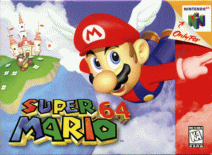
































Super Mario 64

Super Mario 64 is a 1996 platform video game developed and published by Nintendo for the Nintendo 64. It is the first Super Mario game to utilize three-dimensional (3D) graphics. Along with Pilotwings 64, it was one of the launch titles for the console. It was released in Japan on June 23, 1996, and later in North America, Europe, and Australia. It is the best-selling game on the Nintendo 64, with more than eleven million copies sold. An enhanced remake called Super Mario 64 DS was released for the Nintendo DS in 2004.
In the game, Mario explores Princess Peach's castle and must rescue her from Bowser. As one of the earlier 3D platform games, Super Mario 64 is based on open world playability, degrees of freedom through all three axes in space, and relatively large areas which are composed primarily of true 3D polygons as opposed to only two-dimensional (2D) sprites. The game established a new archetype for the 3D genre, much as Super Mario Bros. did for 2D sidescrolling platformers. In the evolution from two dimensions to three, Super Mario 64 places an emphasis on exploration within vast worlds that require the player to complete multiple diverse missions, in addition to the occasional linear obstacle courses as in traditional platform games. While doing so, it still preserves many gameplay elements and characters of earlier Mario games, and the same visual style.
The game has left a lasting impression on 3D game design, particularly notable for its use of a dynamic camera system and the implementation of its 360-degree analog control. The title is acclaimed by many critics and fans as one of the greatest and most revolutionary video games of all time.
Super Mario 64 is a 3D platformer where the player controls Mario through several courses. Each course is an enclosed world in which the player is free to wander in all directions and discover the environment without time limits. The worlds are filled with enemies that attack Mario, as well as friendly creatures that provide assistance, offer information, or ask a favor (such as pink 'peace-loving' Bob-omb Buddies). The player gathers stars in each course; some stars only appear after completing certain tasks, often hinted at by the name of the course. These challenges include defeating a boss, solving puzzles, racing an opponent, and gathering coins. As more stars are collected, more areas of the castle hub world become accessible. The player unlocks doors in the castle with keys obtained by defeating Bowser in special courses. There are many hidden mini-courses and other secrets to the game, most containing extra stars required for the full completion of the game.
There are three special cap power-ups appear in certain areas on many stages. The Wing Cap allows Mario to fly; the Metal Cap makes him immune to most damage, allows him to withstand wind, walk underwater, and be unaffected by noxious gases; and the Vanish Cap renders him partially immaterial and allows him to walk through some obstacles such as wire mesh, as well as granting invulnerability to some forms of damage. Some courses contain cannons that Mario can access by speaking to a pink Bob-omb Buddy. After entering a cannon, Mario can be shot out to reach distant places. When the player has the Wing Cap equipped, cannons can be used to reach high altitudes or fly across most levels quickly.
Mario's abilities in Super Mario 64 are far more diverse than those of previous Mario games. The player can make Mario walk, run, jump, crouch, crawl, swim, climb, kick, or punch using the game controller's analog stick and buttons. Special jumps can be executed by combining a regular jump with other actions, including the double and triple jumps (jumping two and three times in a row, respectively), long jump and backflip. There are also special maneuvers, such as wall jumping—jumping from one wall to another in rapid succession to reach areas that would otherwise be too high. The player can pick up and carry certain items, an ability which is used to solve various puzzles, and swim underwater at various speeds. Mario's life energy slowly diminishes while underwater, representing how long he can hold his breath.
Super Mario 64 is set in Princess Peach's Castle, which consists of three floors, a basement, a moat, and a courtyard. The area outside the castle is an introductory area in which the player can experiment, testing his or her player skills. Scattered throughout the castle are entrances to courses via secret walls and paintings. Super Mario 64 begins with a letter from Princess Peach inviting Mario to come to her castle for a cake she has baked for him. However, when he arrives, Mario discovers that Bowser has invaded the castle and imprisoned the princess and her servants within it using the power of the castle's 120 Power Stars. Many of the castle's paintings are portals to other worlds, in which Bowser's minions keep watch over the stars. Mario explores the castle for these portals to enter the worlds and recover the stars. He gains access to more rooms as he recovers more Power Stars, and eventually traverses three different obstacle courses, each leading to its own battle with Bowser. Defeating Bowser the first two times earns Mario a key for opening another level of the castle. After Mario defeats Bowser in the final battle, Peach is released from the stained-glass window above the castle's entrance. Peach rewards Mario by kissing him on the nose and baking the cake that she had promised him.
How to play:
Click on the joystick icon in the Super Mario 64 online emulator to see how to control the Super Mario 64 game









































Comments